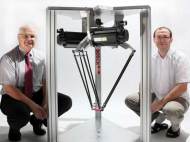Delta Direct Drive robot capable to perform over 200 operations per minute
 In the early 1980s, the industry was in need for a new type of robot capable to manipulate light and small objects at a very high speed. Since necessity is the mother of invention, Reymond Clavel from the École Polytechnique Fédérale de Lausanne (EPFL) committed to find a solution and came up with the Delta robot – a parallel arm robot which revolutionized the packaging industry in 1985.
In the early 1980s, the industry was in need for a new type of robot capable to manipulate light and small objects at a very high speed. Since necessity is the mother of invention, Reymond Clavel from the École Polytechnique Fédérale de Lausanne (EPFL) committed to find a solution and came up with the Delta robot – a parallel arm robot which revolutionized the packaging industry in 1985.
“To be honest, when we had developed the first Delta, I was so enthusiastic that I expected lots of companies to rush to my office to buy one. Not at all! In fact, two years passed before we signed our first licence transfer, because our robot had scared off the industrialists. Its very fine structure, which looked like an umbrella to them, was disconcerting. They thought that it wasn’t robust enough”, said Reymond Clavel, Proffesor at EPFL’s Robotic Systems Laboratory.
Delta robot’s platform is mounted above the workspace. Actuators are used to move 3 "arms" which are jointed to the platform in order to provide it with 3 transitional degrees of freedom (DoF). A part of the robot speed is in its ability to keep its picking appendage in parallel with the workspace while moving items. If needed by process, extends at the middle of the platform can be used in order to enable an additional rotational DoF.
The most recent version of the Delta robot was recently presented in Germany, where it managed to perform over 200 operations per minute. Developed in collaboration with Bosch, the Delta Direct Drive robot can achieve acceleration of over 15G. That is 5G more compared to the previous generation of the robot.
“In particular, we have developed ultra-high-precision robots, designed for use in the areas of electro-erosion, which involves machining very hard materials. These robots are also used in the manipulation and positioning of optical elements”, said Mohamed Bouri, Senior research fellow at the Robotic Systems Laboratory.
While they were developing the newest version of the Delta robot, the researchers had a goal to increase its speed and maintain its precision. Luckily, the lower cost and increased power of new direct drive mechanism enabled researchers to solve the problem less powerful motors had. They required an additional mechanical component which enabled a more effective transmission of the movement, but it also limited the maximum speed of the robot.
Many variations of Delta robot are used in industries with need for high speed and precision. For example, it is used in watch making industry, packaging and even surgery. In collaboration with neurosurgeons at the University Hospital Center of the canton of Vaud, Switzerland, the EPFL researchers developed a tactile feedback device which uses the platform as a 3D controller.









Leave your response!